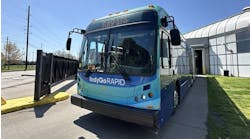The Albuquerque Rapid Transit (ART) project will bring state-of-the-art landscape design and water features to the transit project, with construction scheduled to begin in August. Dekker Perich Sabatini, the state’s largest architecture firm, developed the landscape plans. Each ART station will feature a unique native plant as the theme for that station. Throughout the project there will be bold, dense and modern landscapes showcasing native plants in an urban setting. In addition to station landscaping, there will be native and xeric landscapes in all medians along the ART route where median width allows.
“What we’ve designed is a featured plant used in dense arrangements to reinforce a sense of place, connect people with regional landscapes, and provide a visual respite amid an urban landscape,” said Mimi Burns, chief landscape architect for the ART project. “The stations will look dramatically different from other street corridors around the city.”
“We’ve worked with the landscape design team to ensure Central Avenue, the historic Route 66, feels like Albuquerque and not any other southwestern metropolis,” said Mayor Richard J. Berry. “The design pays tribute to our rich history, while using a modern arrangement to parallel the upgrades ART is creating along the corridor.”
“The consistent application of composition and density at each station provides rhythm and aesthetic continuity while reinforcing a visual brand along Route 66,” added Burns.
Some of the site and landscape improvements as part of the ART construction include:
- New sidewalks
- Street trees
- Median landscaping
- Handicapped accessible ramps
- New crosswalks
- Green infrastructure, which makes the city more functional and livable
- Many stations have raised planters adjacent to the station platforms, which increases planting space and shields pedestrians from passing traffic while creating a green buffer
- At on-street parking sites, street trees will alternate with bands of concrete pavers to increase the green space throughout the corridor
The landscape architect team has worked to ensure the viability of the new plants. By using permeable pavers and structural soil, the health and vitality of the urban forest is enhanced by increasing water, oxygen and nutrient flow to plant root zones. Additionally, roadway bulb-outs in the Nob Hill section provide flow-through Bioswales, which will intercept storm water runoff from the roadway allowing the rainwater to feed the green space rather than be piped away into storm drains.
The team has worked diligently to select the right trees while being aware of complications like underground utilities, overhead lines, traffic signals, boxes, meters and buildings. Selected trees include hardy staples like Frontier Elm, Honey Locust and Urbanite Ash, as well as Desert Willow and New Mexico Olive as accents. Additionally, a wide variety of native and xeric plant material is being used to soften the space and beautify the roadway. These include shrubs, grasses, succulents and flowering perennials. All plants will limit potable water use and thrive in our harsh desert climate.
ART’s landscape design will increase shade, beauty, seasonal interest and diversity, while enhancing the urban forest along Route 66. More information on ART and the landscaping can be found at BRTABQ.com.


